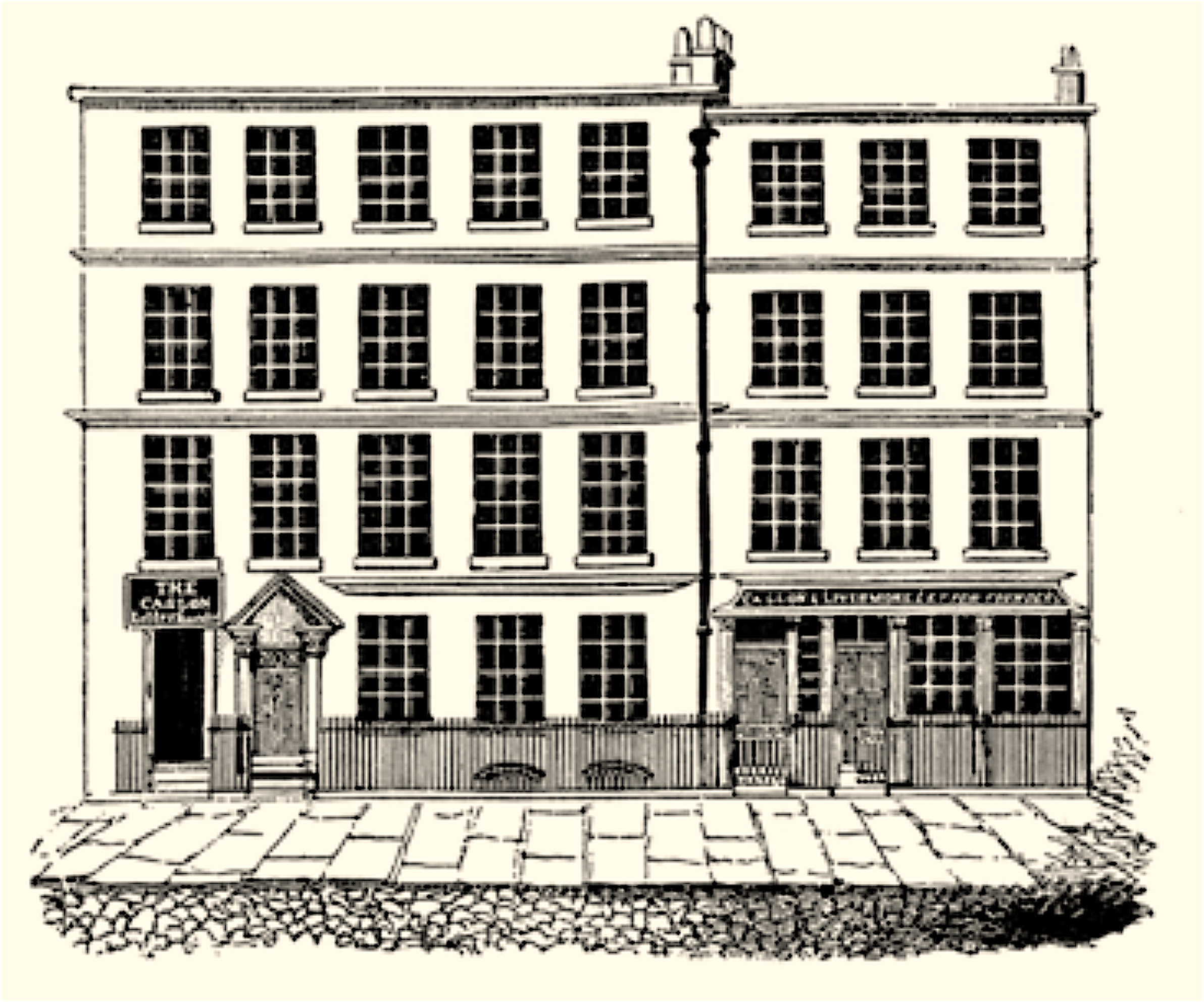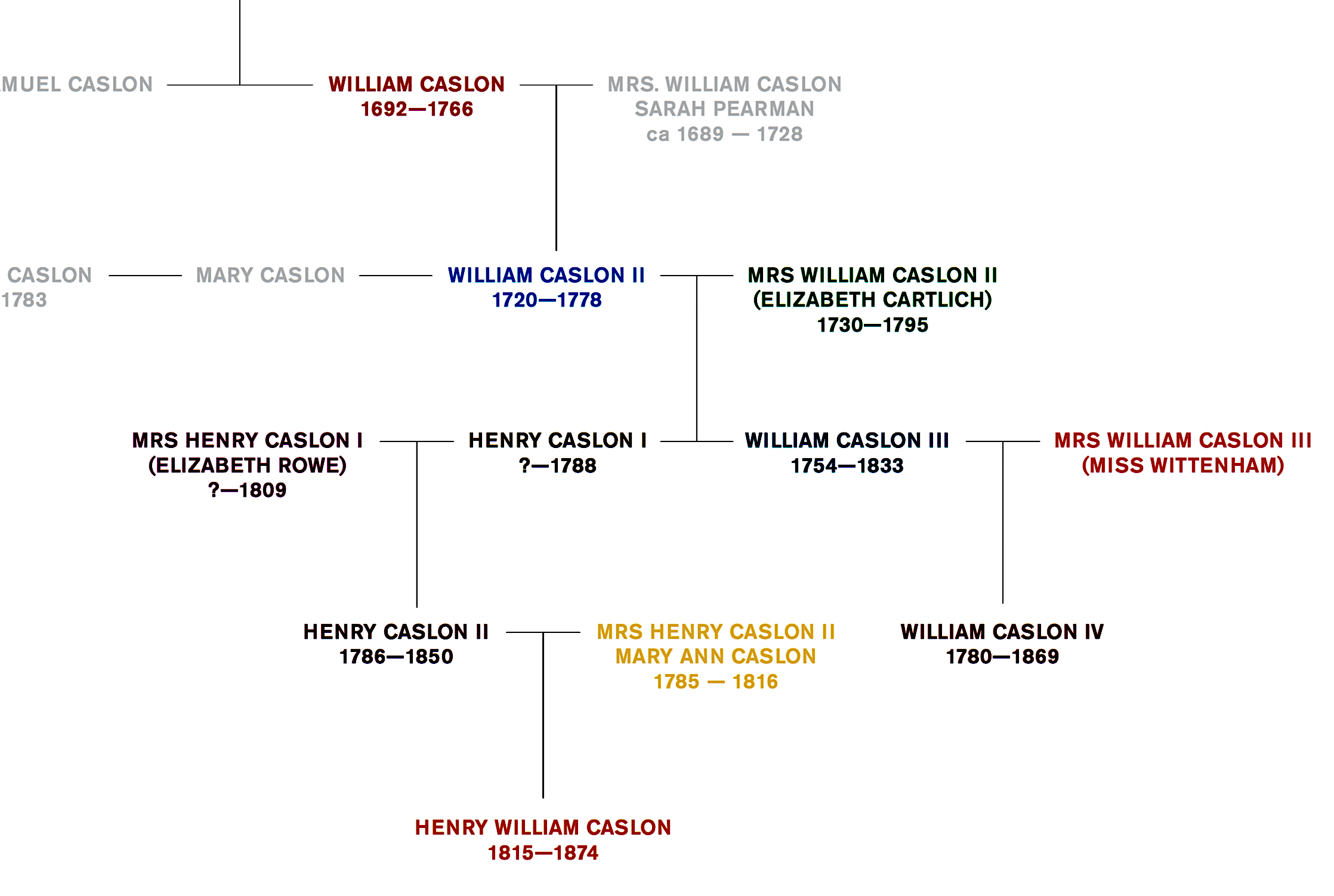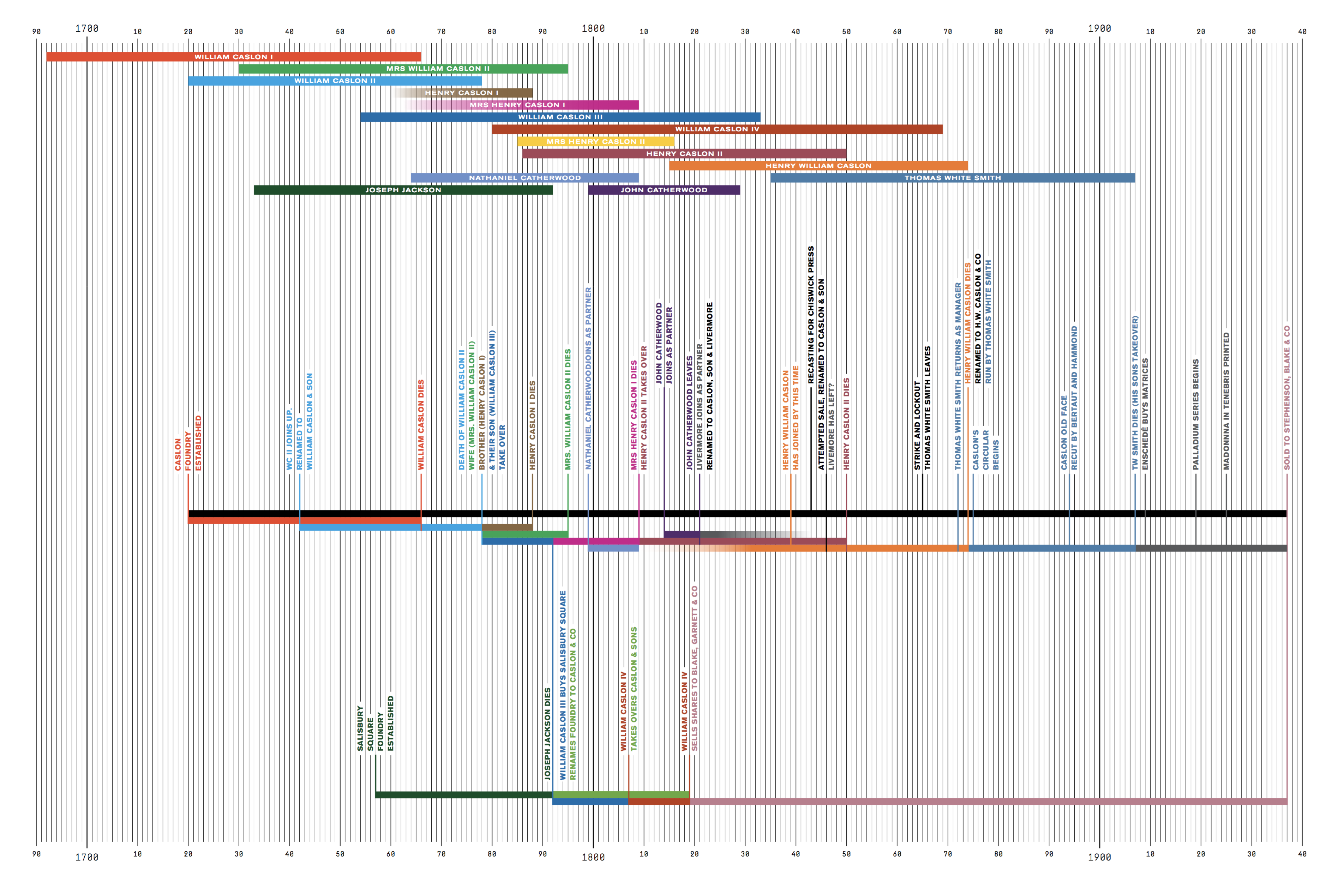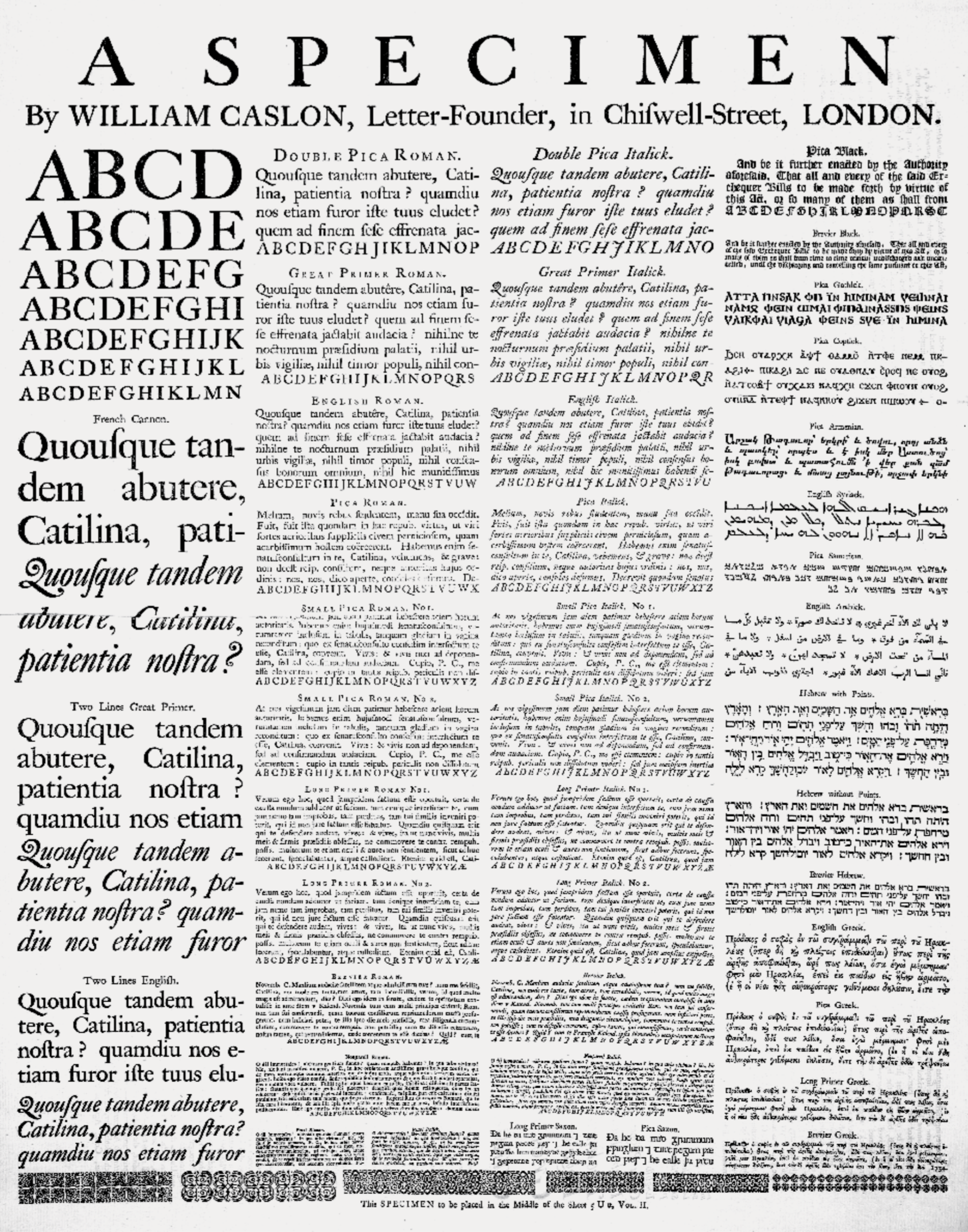|
Caslon: A brief history

A brief history of the Caslon family, as summarized by Dave Forster in 2012 while he was a student at KABK [the text below quotes verbatim passages from his document entitled Another Bloody caslon]. - Introduction. The lineage of the Caslon family is complicated because they all shared similar names, even their wives. Unless initials are present, it should be assumed that the first name is William. If no roman numerals are present afterwards, that person was the first with that name.
- Main influences on Caslon. For many reasons, The Crown of England enforced regulations on the printing presses from the mid-16th century until the beginning of the 18th-century. This dampened efforts to establish type founding in England. Consequently, type was imported, mainly from Holland. Dr. John Fell bought punches and matrices for the Oxford University Press in 1670. Seven years later, Cambridge University Press also imported type from Holland. These were the works of Dirk Voskens and Christoffel van Dijck respectively, who were major influences on Caslon as noted by Morison, Johnson and Lane. Miklos Totfalusi Kis, a Hungarian who had been Voskens' apprentice and who later cut Janson, was also influential. Updike explains the fame and excellence of Caslon's types: While he modelled his letters on Dutch types, they were much better; for he introduced into his fonts a quality of interest, a variety of design, and a delicacy of modelling, which few Dutch types possessed. Dutch fonts were monotonous, but Caslon's fonts were not so. His letters when analyzed, especially in the smaller sizes, are not perfect individually; but in their mass their e ect is agreeable. That is, I think, their secret: a perfection of the whole, derived from harmonious but not necessarily perfect individual letterforms.
- Establishing the foundry. In 1692, William Caslon was born in Cradley, England. After serving an apprenticeship with a metal-worker, he left and began engraving ornamental gun-locks, gun-barrels as well as silver-chasing and making book binding tools, presumably ones used to place lettering on spines and covers. It was only later he became involved with type when two separate strangers noticed his lettering on books found in Mr. Browne's bookshop. The first was Bowyer, the second was John Watts. Both printers recognised Caslon's potential to repair the standard of printing since its decline from the days of Caxton: the elder Mr. Bowyer, [...] accidentally observed in a bookseller's ship a bound book, the lettering on the back of which seem to him to be executed with more than common neatness; and on inquiry nding Mr. Caslon to be the artist by whom the letters had been cut, he was induced to seek an acquaintance with him. Bowyer took Caslon to James's Foundry. Caslon had never been exposed to type founding before. He was asked whether he could undertake the cutting of types, Caslon requested one day to consider. When one day passed he replied that he had no doubt that he could. Bowyer, Watts and Bettenham (another printer) then lent him 500 pounds to establish the Caslon Foundry.
- The growth of the foundry. His first commission was in 1720, an Arabic fount to set the New Testament and Psalters (completed 1727 and 1725 respectively) for the Society for Promoting Christian Knowledge. For the bottom of the specimen he cut the letters of his name in Pica Roman. Mr. Palmer, the author of Psalmanazar's History of Printing encouraged him to complete the whole fount. Caslon's Pica Roman exceeded the quality of many other founders at the time, many of whom Palmer's circumstances as an author relied on. He promptly withdrew his advice and discouraged Caslon from further development. The fame of the Caslon foundry developed through further commissions, including Coptic, Armenian, Gothic and Black letter. His son, Caslon II developed Etruscan and Ethiopic. The foundry became less reliant on its patrons. In 1730, he had the custom of the King's printers, excluding all others. In 1734, after fourteen years of work, the Caslon foundry published a specimen that included thirty-eight founts. Excluding three, all are Caslon's work. Reeds says It placed Caslon absolutely without rival at the head of his profession. One of these specimens resides in the Meermanno Museum.
- William Caslon II, Caslon & Son. By 1742 and 1748, Caslon printed his specimens showing founts created by his son, Caslon II, who was now partner and the firm changed names. The young Caslon proved to be as able as his father. Under his watch, the specimens of 1763 and 1764 displayed twice the amount of founts since the first specimen. Caslon dies two years later in 1766 at Bethnal Green. From here onwards, the history becomes complex. An attempt has been made to simplify it with the aid of a timeline and family tree.
- William Caslon III. When Caslon II died in 1778, the foundry was split between three people. His brother (Henry Caslon I), Wife (Mrs Caslon II) and their son (Caslon III). One specimen appeared in 1785 but nothing else was released until 1800. In 1788, Henry Caslon died, leaving his share to his two-year-old son, H. Caslon II. A major change happened in 1792 when Caslon III sold his shares to his mother, Mrs Caslon II and sister-in-law, Mrs H. Caslon for 3000 pounds. He then purchased Joseph Jackson's foundry and renamed it to Caslon & Co.
- Mrs Henry Caslon---Caslon & Catherwood. Three years after Caslon III left, Mrs Caslon II died without a will. Mrs Henry Caslon was required to purchase the foundry for 520 pounds (a fraction of the price Caslon III had received seven years before). The Caslon name was no longer enough to sell type and the foundry was fading. She commissioned John Drury to cut new types. She also took on Nathaniel Catherwood (a distant relation) as partner and she was able to restore the foundry's reputation by 1808. In 1805, they released an important specimen containing new romans of Caslon and Catherwood. Most cuts were completed between 1802 and 1804. Another specimen was released in 1808 with Stower's Printers Grammar. The original founts of Caslon had been put away and forgotten. According Jane Smith (2010), All the once admired founts of the originator of the foundry have been discarded, and between the specimen of 1785 and 1808 there is absolutely no feature in common. In 1809, Mrs H. Caslon and N. Catherwood both died. Control passed to her son Henry Caslon II.
- Henry Caslon II. H. Caslon II took Nathaniel's brother, John Catherwood as a partner. Together they looked after the business well. Hansard says, the additions and varieties made to the stock of the foundry have been immense. John Catherwood leaves in 1821. One year later, Martin Livermore, a trusted employee is promoted as partner. They built the stock of the foundry towards advertising types like fat faces and Egyptians.
- Henry William Caslon and The Chiswick Press. In 1839, a specimen is released under the name Caslon, Son and Livermore. This signalled Henry William Caslon, the son of Henry Caslon II, joining the firm. In 1844, Charles Whittingham of the Chiswick Press requested the original Caslon, known as Old Face, in Great Primer to print The Diary of Lady Willoughby as the type was appropriate to the story's history. The Caslon foundry had the original matrices in storage and recast Whittingham a small amount of Great Primer. The Chiswick Press continued to use the type for further books and in 1958 used electrotyped matrices to cast type by hand. S. Peterson [The Kelmscott Press: a history of Morris's typographical adventure, University of California Press, 1991, page 22] writes: Unlike modern printers in search of historic designs, the proprietor of the Chiswick Press, was not compelled to have the Caslon type recut; he simply went to the fi rm run by Caslon and discovered that the original matrices were still in storage. 1846 saw an attempted sale of the foundry under the name Caslon & Son (apparently Livermore had left). But no acceptable offer was made. Henry Caslon dies 4 years later. Old Face returned to popular use later in the 1850s when a historicist movement in ne printing adopted the typeface. The foundry then began displaying Old Face in specimens again. The term Old Face refers to the original founts of Caslon, owned by foundry. The first reference appeared in 1854. The name Old Style stems from two events. One in the 1850s when predecessors of the ATF published identical type, most likely from electrotyped matrices with the permission of the Caslon Foundry. The second occurred in Edinburgh at Miller & Richard. Their punchcutter, Phemister made an Old Style in which they have endeavoured to avoid the objectionable peculiarities, whilst retaining the distinctive characteristics of the medieval letters [reference: J. Southward, Modern Printing, 1924, vol. 1 page 106]. This induced the Caslon Foundry into cutting their version too. Reed says, In spite of the vogue for Caslon Old Face, they found it expedient to cut their own copy of Old Style, which was first shown in 1877 and the full range completed in 1880.
- H.W. Caslon & Co. With H. Caslon II dead, H.W. Caslon was the sole proprietor. Thomas White Smith, a trusted employee of the firm since 1857, describes H.W. Caslon as a man of generous impulse but of little wisdom in business matters. The firm then purchased Glasgow Letter Foundry. Alexander and Patrick, the grandsons of the founder joined Caslon & Son and it was renamed to H.W Caslon & Co. In 1865 there was an 8-month-long strike and lockout. Smith and the two Wilson partners left. In 1872, H.W. Caslon became ill and asked Smith to return as manager. He returned and H.W. Caslon died two years later at Medmenham. He was the last male in the Caslon lineage and left the whole foundry to Smith.
- Thomas White Smith. Smith made immeasurable improvements to the business. In 1875 he sets up Caslon's Circular, an important publication regularly issued by the foundry. In 1878-1879 it published articles by De Vinne about the point system for measuring type. Smith was a leading campaigner for its introduction. In 1886 he made a formal proposal that was only accepted by the other founders later, in 1898. It took until 1905 before the transition was complete, according to Southward. They also used Caslon's Circular to vocally oppose the piracy of type using electrotyping and defend themselves against trade publications that criticised them for obstructing the progress of mechanical invention. This was untrue; Smith was an early pioneer of combing matrices in a line, a precursor to the linotype machine. In 1878 there was an article stating an increased demand for Old Face. But there were complaints about irregularity and rough edges then uncommon in modern faces. Smith published the following in The Circular: We are taking steps to improve them [the original founts] so far as smoothness of face is concerned, and to produce them by the machine-casting process, without altering their shapes in the least degree. In the specimen of 1884, it is possible to see the progress of this, a small amount of founts are smoothed out, others are not. Justin Howes (1963-2005), a scholar of Caslon, placed the recutting of Old Face from around 1893. The first size was the Great Primer, equivalent to 18-point. Emile Bertaut and George Hammond were the punchcutters responsible for the work that took place between October 1894 and 1908. In 1896, Smith's three sons joined and changed their name to Caslon-Smith and later to Caslon. In 1900, he retired, the year a newly equipped foundry at Hackney Wick was established. In 1907 he died. Twenty years later in 1937, the Caslon Foundry to Stephenson, Blake & Co.
|
EXTERNAL LINKS
Caslon: A brief history
MyFonts search
Monotype search
Fontspring search
Google search
INTERNAL LINKS
History of type ⦿
Type design in the United Kingdom ⦿
Caslon ⦿
Foundries of the 18th century ⦿
Foundries of the 19th century ⦿
|




